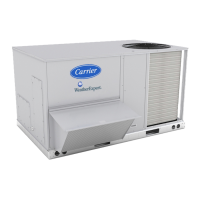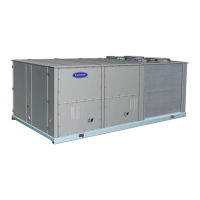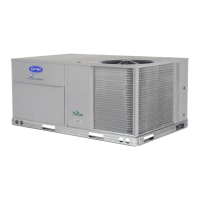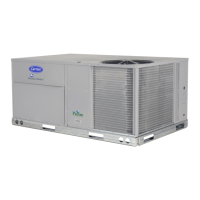33
• Service Test
COOL
RHV (Humidi-MiZer 3-Way
Valve). On Humidi-MiZer equipped units, this item
allows the user to switch the reheat valve from ON to
OFF and vice versa. When RHV is switched to the ON
position, a three-way valve will be energized allowing
refrigerant flow to enter the reheat coil as if in a dehu-
midification mode or reheat mode. When RHV is
switched to the OFF position, the three-way valve will be
deenergized and the unit will revert back to normal cool-
ing. Note that this function only allows manipulation of
RHV if a compressor on Circuit B has already been
turned ON. To manually exercise this valve without an
active Circuit B compressor, see the section titled Ser-
vice Test
HMZR
RHV. To view the actual valve posi-
tion at any time, the user can use the Outputs menu
(Outputs
COOL
RHV).
• Service Test
COOL
C.EXV (HMV-1: Condenser
EXV Position). On Humidi-MiZer equipped units, this
item allows the user to exercise the valve that controls
refrigerant flow to the Circuit B condenser. To exercise
the valve, RHV must first be switched to ON (Service
Test
COOL
RHV) and a Circuit B compressor must
be commanded ON. The valve default position is 100%
(completely open). The user will be able to adjust the
valve from 0 to 100% through this function. The only
constraint on the valve position is that the percentage
sum of the bypass valve (Service Test
COOL
B.EXV) and condenser valve must equal 100%. For
example, if the condenser modulating valve is only 80%
open, then the gas bypass modulating valve must remain
at least 20% open. The effect of closing the condenser
valve will be to increase the supply-air temperature
(additional reheat capacity). To view the actual valve
position at any time, the user can use the Outputs menu
(Outputs
COOL
C.EXV).
• Service Test
COOL
B.EXV (HMV-2: Bypass EXV
Position). On Humidi-MiZer equipped units, this item
allows the user to exercise the valve that controls dis-
charge gas bypass around the Circuit B condenser. To
exercise the valve, RHV must first be switched to ON
(Service Test
COOL
RHV) and a Circuit B compres-
sor must be commanded ON. The valve default position
is 0% (completely closed). The user will be able to adjust
the valve from 0 to 100% through this function. The only
constraint on the valve position is that the percentage
sum of the bypass valve and condenser valve (Service
Test
COOL
C.EXV) must equal 100%. For example,
if the condenser modulating valve is only 80% open,
then the gas bypass modulating valve must remain at
least 20% open. The effect of opening the bypass valve
will be to increase the supply air temperature (additional
reheat capacity). To view the actual valve position at any
time, the user can use the Outputs menu (Outputs
COOL
B.EXV).
Heating — The Heat Test Mode sub-menu will offer auto-
matic fan start-up if not a gas-fired heat unit. On gas heat units,
the IGC (integrated gas controller) feedback from the gas con-
trol units will bring the fan on as required.
Within this sub-menu, control of the following is possible:
• Service Test
HEAT
HT.ST (Requested Heat Stage).
When this item is non-zero, the currently configured heat
type will energize the corresponding heat relay pattern
that reflects the requested stage. In addition the upper
limit will be clamped to reflect the maximum configured
number of stages. When non-zero, the heat relays will be
“read-only” and reflect the currently selected pattern.
• Service Test
HEAT
HT.1-10, Service Test
HEAT
HIR (Manual Heat Relay Control). If the “Heat
Stage Request” item is set to zero, it will be possible to
individually control the heat relays, including the heat
interlock relay.
• Service Test
HEAT
H1.CP (Modulating Heat Capac-
ity). If configured for modulating gas or SCR electric
heat, the user will be able to manually control the capac-
ity of the modulating heat section (0 to 100%). The
requested heat stage must be greater than or equal to 1 or
heat relay 1 must be on before the control will accept a
modulating heat capacity request. If neither case is true,
the control will overwrite the modulating heat request
back to 0%.
• Service Test
HEAT
HTC.C (Ht Coil Command Posi-
tion). If configured for hydronic heat type, the user will
be able to manually control the positioning of the actua-
tor which controls hot water (0 to 100%).
SERVICE COMPONENT TESTS
Auto-component testing is the automated testing procedures
of a component or a group of components. Auto-component
testing can be used during commissioning of a unit to verify
that components are functioning properly. It can also be used as
a diagnostics routine for troubleshooting.
Control Description (Overview) — The 40/50N Se-
ries large rooftop unit is capable of performing auto-compo-
nent tests. The auto-component tests appear in Navigator under
the Service Test menu (Service Test
AC.DT):
The unit must be in Service Test mode to perform the auto-
component tests (Service Test
TEST
ON).
Starting another test before a currently running test has
completed will cancel the running test and reset all outputs be-
fore starting the newly requested test.
Setting Service Test mode to "OFF" while running an auto-
component test will cancel the running test and reset all out-
puts.
For a complete description of notices, alerts and alarms ref-
erenced, see the Alarms and Alerts section.
Auto-component tests will have a status indicated by the
following:
1. Not Run
2. Running
3. Pass
4. Fail
The results of all auto-component tests will default to "NOT
RUN."
After power cycling the MBB, the results of all auto-com-
ponent tests will default to "NOT RUN."
If the required conditions for the test are not met, the test
will not be allowed to run. Note that there may be no indication
for the possible reasons why a test might not run.
For each auto-component test, if the verification criteria is
met, test status will display 'PASS,' if the verification criteria is
not met, test status will display 'FAIL.'
CP.TS Compressor Auto-Test
DS.TS Dig Scroll Auto-Test
EX.TS EXVS Auto-Component Test
CD.TS Charge Tst without Lqd Sens.
CL.TS Charge Tst with Lqd Sensors
ML.TS MLV/HGBP Auto-Test
SF.TS Supply Fan Auto-Test
RSLT Comps Auto-Test Results

